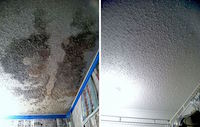Hurricane Irma had slowed down to a tropical storm by the time she reached Georgia, reducing the amount of expected structural damage to homes. Flood waters still may have left behind a sneaky and dangerous after-effect: mold.
“Heavy rains can produce an explosion of mold. Molds produce spores that spread through the air and form new mold growths or colonies when the conditions are right,” said University of Georgia Cooperative Extension expert Pamela Turner. “Mold is all around us. It can grow on any organic material, as long as there are moisture and oxygen. Molds are types of fungi and all fungi need moisture to live.”
The key to controlling mold and mold spores is to control the moisture and do it quickly, according to Turner, a housing and environment specialist with the UGA College of Family and Consumer Sciences. New mold colonies can form in as little as two to three days.
Mold can cause fungal allergy and respiratory infections or worsen certain illnesses like asthma, according to the Centers for Disease Control and Prevention.
“Clean any damp or wet materials and furnishings within 24 to 48 hours of the water damage,” Turner said. “Porous materials like carpet, wood and ceiling tiles may need to be discarded. Non-porous materials made from metal, solid wood or plastic can be cleaned with detergent and water and then dried completely.”
To treat mold, Turner recommends following these steps from UGA Extension:
- Wear protective gear during clean up. Reduce skin exposure by wearing gloves, long sleeves, long pants and sturdy shoes. Protect eyes by wearing goggles. To avoid breathing spores or fragments, wear a respirator rated N95 or higher.
- Isolate work areas and ventilate these areas to the outdoors. Cleaning disturbs mold colonies, which can release spores into the air. Seal off the areas being cleaned. Open windows, but do not run the air conditioner during cleanup.
- Remove and discard moldy materials. Throw out porous or contaminated materials like carpeting, carpet padding, mattresses and paper products. Cut away, dispose of and replace wet wallboard and insulation. Wash textile products. To reduce the release of mold spores, cover moldy material with plastic sheeting before removing them from your house.
- Clean all surfaces with a damp sponge or cloth and a mild detergent. You do not need to use bleach or a disinfectant.
- Flush the air. After cleaning and disinfecting, air out the space using fans in windows.
- Dry the area as quickly as possible. Once the area has been cleaned and the air flushed, close the windows and use air conditioning, fans and a dehumidifier to speed the drying process.
- Remain on mold alert. Continue looking for signs of moisture or new mold growth.
“Most small areas of mold – those less than 10 square feet – can be cleaned without hiring a professional, but care should be taken to reduce health risks,” Turner said. “UGA Extension does not provide or recommend mold testing. There are some professional labs that offer this service. Testing will give you the name of the mold, but your time and money are better spent fixing the problem.”
To prevent mold from growing in your house in the future, UGA Extension experts suggest following these steps to reduce moisture levels in your house.
- Turn on the exhaust fan in the bathroom when you take a shower and leave it on for about 5 minutes after you shower.
- Turn on the kitchen exhaust fan when you are cooking.
- Check and repair any leaky kitchen and bathroom faucets as well as other plumbing.
- Remove at least one-third of the contents of your closets to provide increased airflow and reduce the risk of mold. Install a louvered door on closets or keep closet doors open.
- Purchase a humidistat to monitor the relative humidity inside your house. (In areas with high humidity, like Georgia, keep the indoor level below 60 percent.)
- Vent your clothes dryer to the outside.
- Make sure water does not pool around the foundation of your house.
If it does, clean, repair or replace gutters and make sure downspouts direct the water away from the foundation. Also, check the grading of the soil around the foundation of your house. It should have a gradual slope away from the foundation.
For more information, visit the UGA Extension website at fcs.uga.edu/extension/mold-safety.








